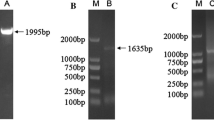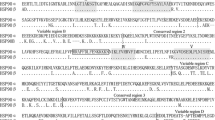Abstract
Heat shock protein 90 (HSP90) works as a multi-functional chaperone and is involved in the regulation of many essential cellular pathways. In this study, we have identified a full-length complementary DNA (cDNA) of HSP90 (FcHSP90) from Chinese shrimp Fenneropenaeus chinensis. FcHSP90 full-length cDNA comprised 2,552 bp, including a 2,181-bp open reading frame encoding 726 amino acids. Both homology analyses using alignment with previously identified HSP90 and a phylogeny tree indicated that FcHSP90 was a cytoplasmic HSP90. Real-time reverse transcription polymerase chain reaction analysis revealed that FcHSP90 was ubiquitously expressed in all the examined tissues but with highest levels in ovary of F. chinensis. FcHSP90 mRNA levels were sensitively induced by heat shock (from 25°C to 35°C) and reached the maximum at 6 h during heat shock treatment. Under hypoxia conditions, FcHSP90 mRNA levels, in both hemocytes and gill, were induced at 2 h and depressed at 8 h during hypoxia stress. The assessment of FcHSP90 mRNA levels under heat shock and hypoxia stresses indicated that the transcription of FcHSP90 was very sensitive to heat shock and hypoxia, so we deduced that FcHSP90 might play very important roles for shrimp to cope with environmental stress.






Similar content being viewed by others
References
Ali A, Bharadwaj S, O’Carroll R, Ovsenek N (1998) HSP90 interacts with and regulates the activity of heat shock factor 1 in Xenopus oocytes. Mol Cell Biol 18:4949–4960
Bachère E, Chagot D, Grizel H (1988) Separation of Crassostrea gigas hemocytes by density gradient centrifugation and counterflow centrifugal elutriation. Dev Comp Immunol 12:549–559 doi:10.1016/0145-305X(88)90071-7
Bendena WG, Southgate AA, Garbe JC, Pardue ML (1991) Expression of heat shock locus hsr-omega in nonstressed cells during development in Drosophila melanogaster. Dev Biol 144:65–77 doi:10.1016/0012-1606(91)90479-M
Brown MA, Zhu L, Schmidt C, Tucker PW (2007) Hsp90-From signal transduction to cell transformation. Biochem Biophys Res Commun 363:241–246 doi:10.1016/j.bbrc.2007.08.054
Cellura C, Toubiana M, Parrinello N, Roch P (2006) HSP70 gene expression in Mytilus galloprovincialis hemocytes is triggered by moderate heat shock and Vibrio anguillarum, but not by V. splendidus or Micrococcus lysodeikticus. Dev Comp Immunol 30:984–997 doi:10.1016/j.dci.2005.12.009
Currie S, Tufts B (1997) Synthesis of stress protein 70 (Hsp 70) in rainbow trout (Oncorhynchus mykiss) red blood cells. J Exp Biol 200:607–614
David E, Tanguy A, Pichavant K, Moraga D (2005) Response of the Pacific oyster Crassostrea gigas to hypoxia exposure under experimental conditions. FEBS J 272:5635–5652 doi:10.1111/j.1742-4658.2005.04960.x
Deane EE, Kelly SP, Luk JCY, Woo NYS (2002) Chronic salinity adaptation modulates hepatic heat shock protein and insulin-like growth factor I expression in black sea bream. Mar Biotechnol 4:193–205
Farcy E, Serpentini A, Fiévet B, Lebel JM (2007) Identification of cDNAs encoding HSP70 and HSP90 in the abalone Haliotis tuberculata: Transcriptional induction in response to thermal stress in hemocyte primary culture. Comp Biochem Physiol Part B 146:540–550 doi:10.1016/j.cbpb.2006.12.006
Fisher DL, Mandart E, Doree M (2000) Hsp90 is required for c-Mos activation and biphasic MAP kinase activation in Xenopus oocytes. EMBO J 19:1516–1524 doi:10.1093/emboj/19.7.1516
Gao Q, Song LS, Ni DJ, Wu LT, Zhang H, Chang YQ (2007) cDNA cloning and mRNA expression of heat shock protein 90 gene in the haemocytes of Zhikong scallop Chlamys farreri. Comp Biochem Physiol Part B 147:704–715 doi:10.1016/j.cbpb.2007.04.010
Gupta RS (1995) Phylogenetic analysis of the 90 kD heat shock family of protein sequences and an examination of the relationship among animals, plants, and fungi species. Mol Biol Evol 12:1063–1073
Hartl FU, Hayer-Hart M (2002) Molecular chaperones in the cytosol: from nascent chain to folded protein. Science 295:1852–1858 doi:10.1126/science.1068408
Hur E, Kim HH, Choi SM et al (2002) Reduction of hypoxia-induced transcription through the repression of hypoxia-inducible factor-1α/aryl hydrocarbon receptor nuclear translocator DNA binding by the 90-kDa heat-shock protein inhibitor. Radicicol Mol Pharmacol 62:975–982 doi:10.1124/mol.62.5.975
Isaacs JS, Jung YJ, Mimnaugh EG, Martinez A, Cuttitta F, Neckers LM (2002) Hsp90 regulates a von Hippel Lindau-independent hypoxia-inducible factor-1 alpha-degradative pathway. J Biol Chem 277:29936–29944 doi:10.1074/jbc.M204733200
Isaacs JS, Jung YJ, Neckers L (2004) Aryl hydrocarbon nuclear translocator (ARNT) promotes oxygen-independent stabilization of hypoxia-inducible factor-1 by modulating an hsp90-dependent regulatory pathway. J Biol Chem 279:16128–16135 doi:10.1074/jbc.M313342200
Jiao CZ, Wang ZZ, Li FH, Zhang CS, Xiang JH (2004) Cloning, sequencing and expression analysis of cDNA encoding a constitutive heat shock protein 70 (HSC70) in Fenneropenaeus chinensis. Chi Sci Bull 49:2385–2393 doi:10.1360/982004-120
Kültz D (1996) Plasticity and stressor specificity of osmotic and heat shock responses of Gillichthys mirabilis gill cells. Am J Physiol 271:C1181–C1193
Lang L, Miskovic D, Lo M, Heikkila JJ (2000) Stress-induced, tissue specific enrichment of hsp 70 mRNA accumulation in Xenopus laevis embryos. Cell Stress Chaperones 5:36–44 doi:10.1379/1466-1268(2000)005<0036:SITSEO>2.0.CO;2
Liu J, Yang WJ, Zhu XJ, Karouna-Renier NK, Rao RK (2004) Molecular cloning and expression of two HSP70 genes in the prawn, Macrobrachium rosenbergii. Cell Stress Chaperones 9:313–323 doi:10.1379/CSC-40R.1
Livak KJ, Schmittgen TD (2001) Analysis of relative gene expression data using real-time quantitative PCR and the \(2^{ - \Delta \Delta {\text{CT}}} \) Method. Methods 25:402–408 doi:10.1006/meth.2001.1262
Lo WY, Liu KF, Liao IC, Song YL (2004) Cloning and molecular characterization of heat shock cognate 70 from tiger shrimp (Penaeus monodon). Cell Stress Chaperones 9:332–343 doi:10.1379/CSC-47R.1
Malago JJ, Koninkx JF, van Dijk JE (2002) The heat shock response and cytoprotection of the intestinal epithelium. Cell Stress Chaperones 7:191–199 doi:10.1379/1466-1268(2002)007<0191:THSRAC>2.0.CO;2
McDonough H, Patterson C (2003) CHIP: a link between the chaperone and proteasome systems. Cell Stress Chaperones 8:303–308 doi:10.1379/1466-1268(2003)008<0303:CALBTC>2.0.CO;2
Minami Y, Kawasaki H, Minami M, Tanahashi N, Tanaka K, Yahara I (2000) A critical role for the proteasome activator PA28 in the Hsp90-denpendent protein refolding. J Biol Chem 275:9055–9061 doi:10.1074/jbc.275.12.9055
Molina A, Biemar F, Müller F, Iyengar A, Prunet P, Maclean N, Martial JA, Muller M (2000) Cloning and expression analysis of an inducible HSP70 gene from tilapia fish. FEBS Letters 474:5–10 doi:10.1016/S0014-5793(00)01538-6
Muller L, Schaupp A, Walerych D, Wegele H, Buchner J (2004) Hsp90 regulates the activity of wild type p53 under physiological and elevated temperatures. J Biol Chem 279:48846–48854 doi:10.1074/jbc.M407687200
Myrmel T, McCully JD, Malkin L, Krukenkamp IB, Levitsky S (1994) Heat shock protein 70 mRNA is induced by anaerobic metabolism in rat hearts. Circulation 90:299–305
Palmisano AN, Winton JR, Dickhoff WW (2000) Tissue-specific induction of Hsp90 mRNA and plasma cortisol response in chinook salmon following heat shock, seawater challenge, and handling challenge. Mar Biotechnol 2:329–338
Pearl LH, Prodromou C (2006) Structure and mechanism of the Hsp90 molecular chaperone machinery. Annu Rev Biochem 75:271–294 doi:10.1146/annurev.biochem.75.103004.142738
Piano A, Franzellitti S, Tinti F, Fabbri E (2005) Sequencing and expression pattern of inducible heat shock gene products in the European flat oyster, Ostrea edulis. Gene 361:119–126 doi:10.1016/j.gene.2005.06.034
Picard D (2002) Heat-shock protein 90, a chaperone for folding and regulation. Cell Mol Life Sci 59:1640–1648 doi:10.1007/PL00012491
Pratt WB, Toft DO (2003) Regulation of signaling protein function and trafficking by the hsp90/hsp70-based chaperone machinery. Exp Biol Med 228:111–133
Prodromou C, Roe SM, Piper PW, Pearl LH (1997) A molecular clamp in the crystal structure of the N-terminal domain of the yeast Hsp90 chaperone. Nat Struct Biol 4:477–482 doi:10.1038/nsb0697-477
Sanders BM, Martin LS, Nelson WG, Phelps DK, Welch W (1991) Relationship between accumulation of a 60 kDa stress protein and scope for growth in Mytilus edulis exposed to a range of copper concentrations. Mar Environ Res 31:81–97 doi:10.1016/0141-1136(91)90021-Y
Schill RO, Görlitz H, Köhler HR (2003) Laboratory simulation of a mining accident: acute toxicity, hsc/hsp70 response, and recovery from stress in Gammarus fossarum (Crustacea, Amphipoda) exposed to a pulse of cadmium. BioMetals 16:391–401 doi:10.1023/A:1022534326034
Schlesinger MJ (1990) Heat shock proteins: a mini review. J Biol Chem 265:12111–12114
Song LS, Wu LT, Ni DJ, Chang YQ, Xu W, Xing KZ (2006) The cDNA cloning and mRNA expression of heat shock protein 70 gene in the haemocytes of bay scallop (Argopecten irradians, Lamarck 1819) responding to bacteria challenge and naphthalin stress. Fish Shellfish Immunol 21:335–345 doi:10.1016/j.fsi.2005.12.011
Spees JL, Chang SA, Snyder MJ, Chang ES (2002) Thermal acclimation and stress in the American lobster, Homarus americanus: equivalent temperature shifts elicit unique gene expression patterns for molecular chaperones and polyubiquitin. Cell Stress Chaperones 7:97–106 doi:10.1379/1466-1268(2002)007<0097:TAASIT>2.0.CO;2
Terasawa K, Minami M, Minam Y (2005) Constantly updated knowledge of Hsp90. J Biochem 137:443–447 doi:10.1093/jb/mvi056
Travers SA, Fares MA (2007) Functional coevolutionary networks of the Hsp70-Hop-Hsp90 system revealed through computational analyses. Mol Biol Evol 24:1032–1044 doi:10.1093/molbev/msm022
Williams JH, Farag AM, Stansbury MA, Young PA, Bergman HL, Petersen NS (1996) Accumulation of HSP 70 in juvenile and adult rainbow trout gill exposed to metal-contaminated water and/or diet. Environ Toxicol Chem 15:1324–1328 doi:10.1897/1551-5028(1996)015<1324:AOHIJA>2.3.CO;2
Xiang JH (2002) Over 10, 000 expressed sequence tags from Fenneropenaeus chinensis. In: Abstract of International Aquaculture Conference and Exposition, Beijing, p 837
Yavelsky V, Vais O, Piura B, Wolfson M, Rabinovich A, Fraifeld V (2004) The role of Hsp90 in cell response to hyperthermia. J Therm Biol 29:509–514 doi:10.1016/j.jtherbio.2004.08.078
Zhang H, Burrows F (2004) Targeting multiple signal transduction pathways through inhibition of Hsp90. J Mol Med 82:488–499
Acknowledgements
This work was supported by the National High-Tech Research and Development Program of China (863 program) 2006AA09Z424 and 2006AA10A402, the Major State Basic Research Development Program of China (973 program) 2006CB101804.
Author information
Authors and Affiliations
Corresponding author
Rights and permissions
About this article
Cite this article
Li, F., Luan, W., Zhang, C. et al. Cloning of cytoplasmic heat shock protein 90 (FcHSP90) from Fenneropenaeus chinensis and its expression response to heat shock and hypoxia. Cell Stress and Chaperones 14, 161–172 (2009). https://doi.org/10.1007/s12192-008-0069-6
Received:
Revised:
Accepted:
Published:
Issue Date:
DOI: https://doi.org/10.1007/s12192-008-0069-6




